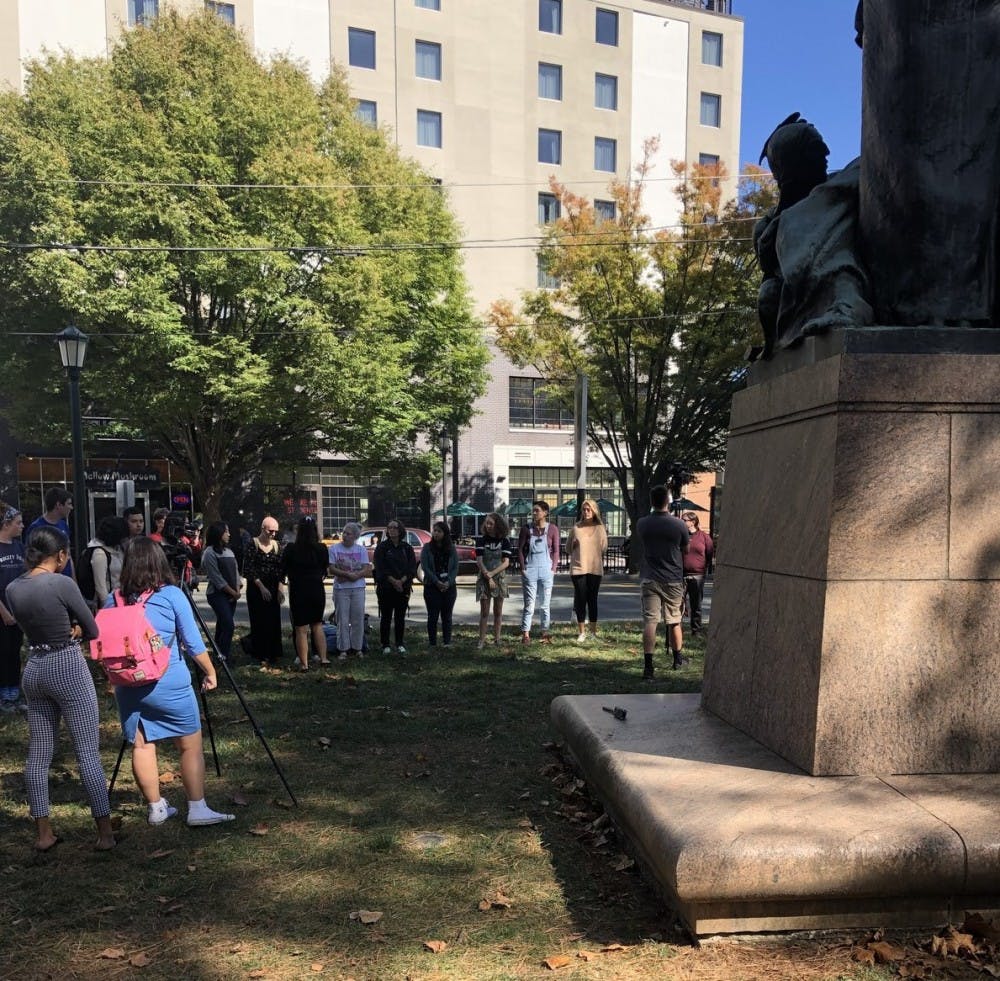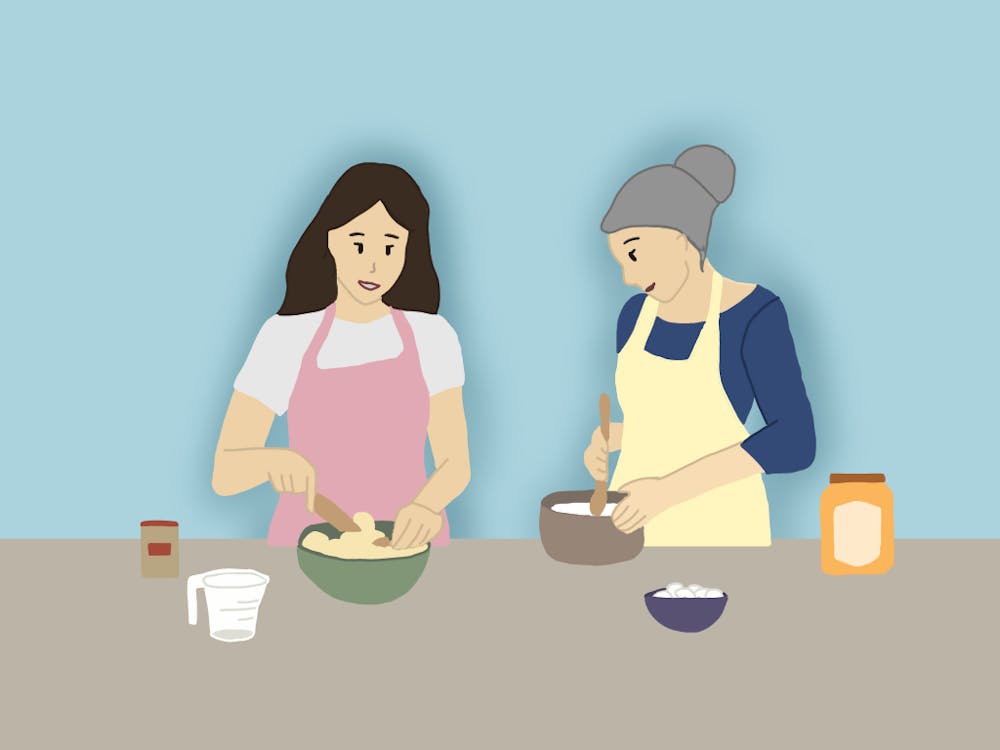Roughly 50 participants marched to the George Rogers Clark statue Monday in honor of Indigenous Peoples’ Day and in protest of Columbus Day. Participants stood in solidarity around the statue and performed a sage ritual as a unified sign of respect towards indigenous people.
The U.S. federal government recognizes the second Monday of October as Columbus Day, a holiday commemorating European colonist Christopher Colombus’s arrival in North America. The goal of Indigenous Peoples’ Day — which is held on the same day as Columbus Day — is to push back against history that paints Columbus as a conquering hero. Instead, Indigenous Peoples’ Day honors Native American people, whose land Columbus pillaged and stole upon his arrival in North America.
“We are not a conquered people — we are still here, fighting for our right to be heard,” said Anthony Malabad, fourth-year College student and president of the Native American Student Union.
Participants met at the Lawn side of the Rotunda. The event was co-sponsored by the NASU, the Latinx Student Alliance, Political Latinxs United for Movement and Action in Society, Virginia Student Environmental Coalition and Central Americans for Empowerment.
Following brief remarks from Malabad and a representative from the Multicultural Student Center, participants marched along the Corner to the George Rogers Clark statue on West Main Street.
According to Zac Russell, second-year College student and NASU member, the march was in part a protest of the statue of George Rogers Clark. Clark, an American militia officer, killed many indigenous people in the Northwest Territories, including those from the Shawnee and the Miami tribes.
“[The march is] in honor of Indigenous People’s Day, which is … a way of … flipping the narrative of Columbus Day,” Russell said.
Planning for the march began about two weeks prior to Indigenous Peoples’ Day. Malabad said that NASU met with representatives from the LSA, PLUMAS and VSEC to discuss ideas.
“We wanted to do something for Indigenous Peoples’ Day,” Malabad said. “Two years ago we did [a march], but it was a small-scale thing. So we brainstormed ideas, and this event kind of arose out of that meeting. It definitely was a team effort.”
Once participants reached the statue, they heard a speech from Malabad and gathered around the statue in a large circle. They then witnessed a traditional Native American sage ritual during which a member of NASU burned bundles of sage and carried the burning herbs around the circle. The burning sage traditionally represents cleansing, and participants wafted the smoke from the bundles onto their faces and bodies to cleanse themselves. The NASU representative closed the ritual by wafting the smoke onto the statue, thereby cleansing it as well.
The event attracted University students and Charlottesville community members, Native Americans and non-Native Americans alike. Fourth-year College student Ruthie Rosenfeld heard about the event from fellow students in her global development studies major.
“I decided to come to this event because I wanted to show support and solidarity for the indigenous community here in Charlottesville and throughout the United States,” Rosenfeld said. “And I think it’s important that we have events like these … in order to make Charlottesville, U.Va. and the entire community a more inclusive place for everyone.”
Charlottesville resident Carmen Tallbear-Edmunds chose to attend the event in support of her indigenous family.
“My mom’s from the Sisseton Wahpeton tribe,” Tallbear-Edmunds said. “She grew up on the reservation, and my grandmother lives there and my cousins live there, so I grew up connected in that way, but I’ve always grown up off the reservation.”
Tallbear-Edmunds also detailed that she is marching to give a voice to missing endangered indigenous women. The phrase “endangered indigenous women” to which Tallbear-Edmunds referred represents a very specific and little-known issue in the United States, which Russell explained further.
“Indigenous women and girls go missing at an alarming rate and are often found murdered [or] victims of sexual abuse,” Russell said. “It’s a problem that nobody talks about. Part of the problem is that indigenous nations … do not have the authority on their own land to prosecute non-natives for crimes against native women.”
Some marchers, including Tallbear-Edmunds, painted a red handprint on their faces for the march as a symbol to show solidarity with these women.
In addition to bringing awareness to the issue of missing endangered indigenous women, another goal of the march was to demand the removal or at least a recontextualization of the George Rogers Clark statue.
“The … imagery on [the statue] is … not just the standard dude on a horse,” Malabad said. “It’s a dude on a horse with his buddies with [guns] and gunpowder … and they’re getting ready to attack.”
A petition to have the Clark statue removed was created this past summer by Charlottesville community member David Swanson. Swanson presented the petition to President Jim Ryan, who passed it along to the Commission on the University in the Age of Segregation, which focuses on the University’s role in racial segregation in the 19th and 20th centuries. The petition is still accepting signatures.
“U.Va. owns that statue, so we’re trying … to draw attention to the petition,” Malabad said. “Actually, after [Monday’s] event we tried to get a whole bunch of new signatures.”
Indigenous Peoples’ Day represents a reclaiming of Columbus Day and the spirit of reclamation — of stolen land, of the rights of indigenous women and of the local community. This spirit was palpable at the march.
Correction: This article previously stated that the march was co-sponsored by four organizations, including the Native American Student Union, the Latinx Student Alliance, Political Latinxs United for Movement and Action in Society and Virginia Student Environmental Coalition. Central Americans for Empowerment also helped organize the event. The article has been updated to reflect that five organizations participated.







